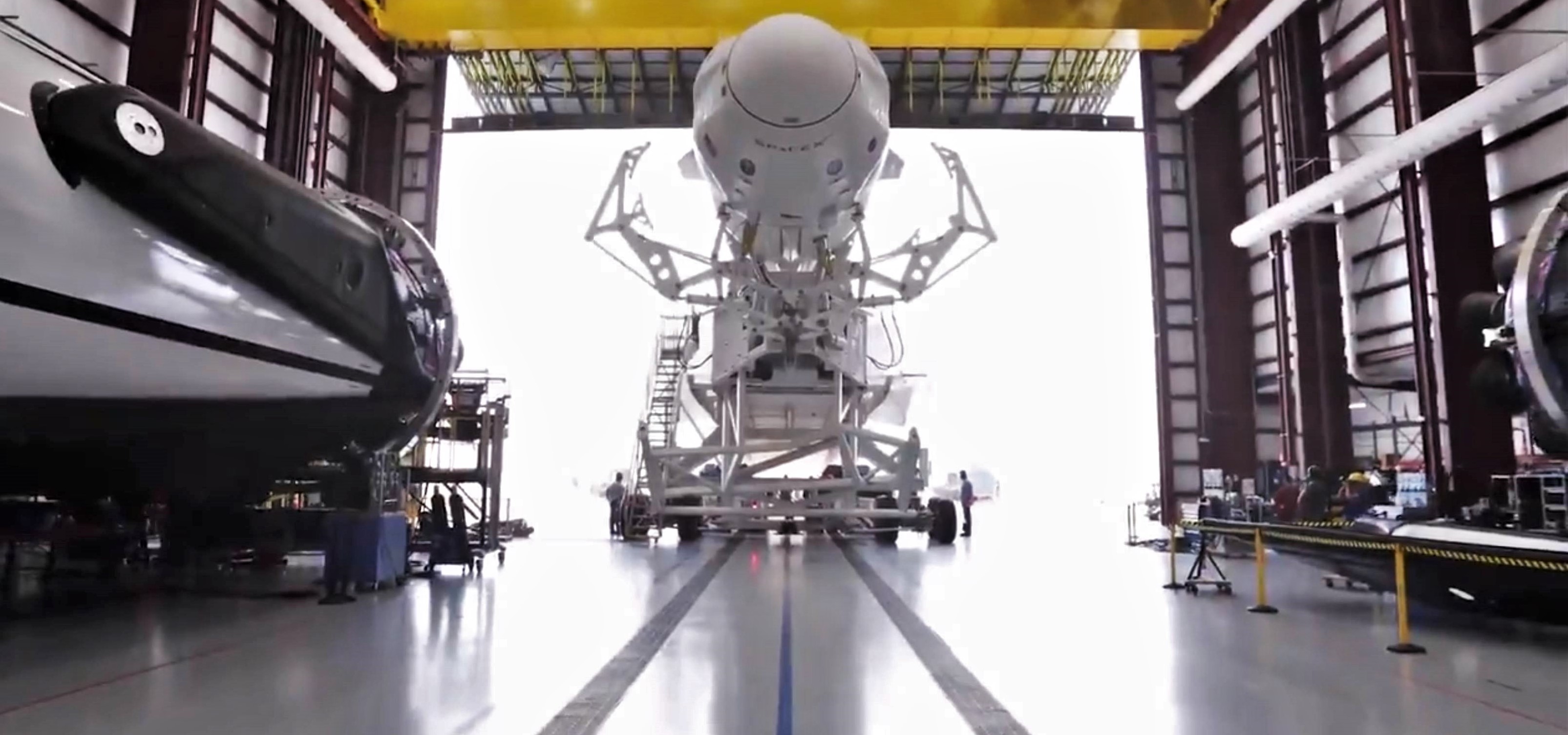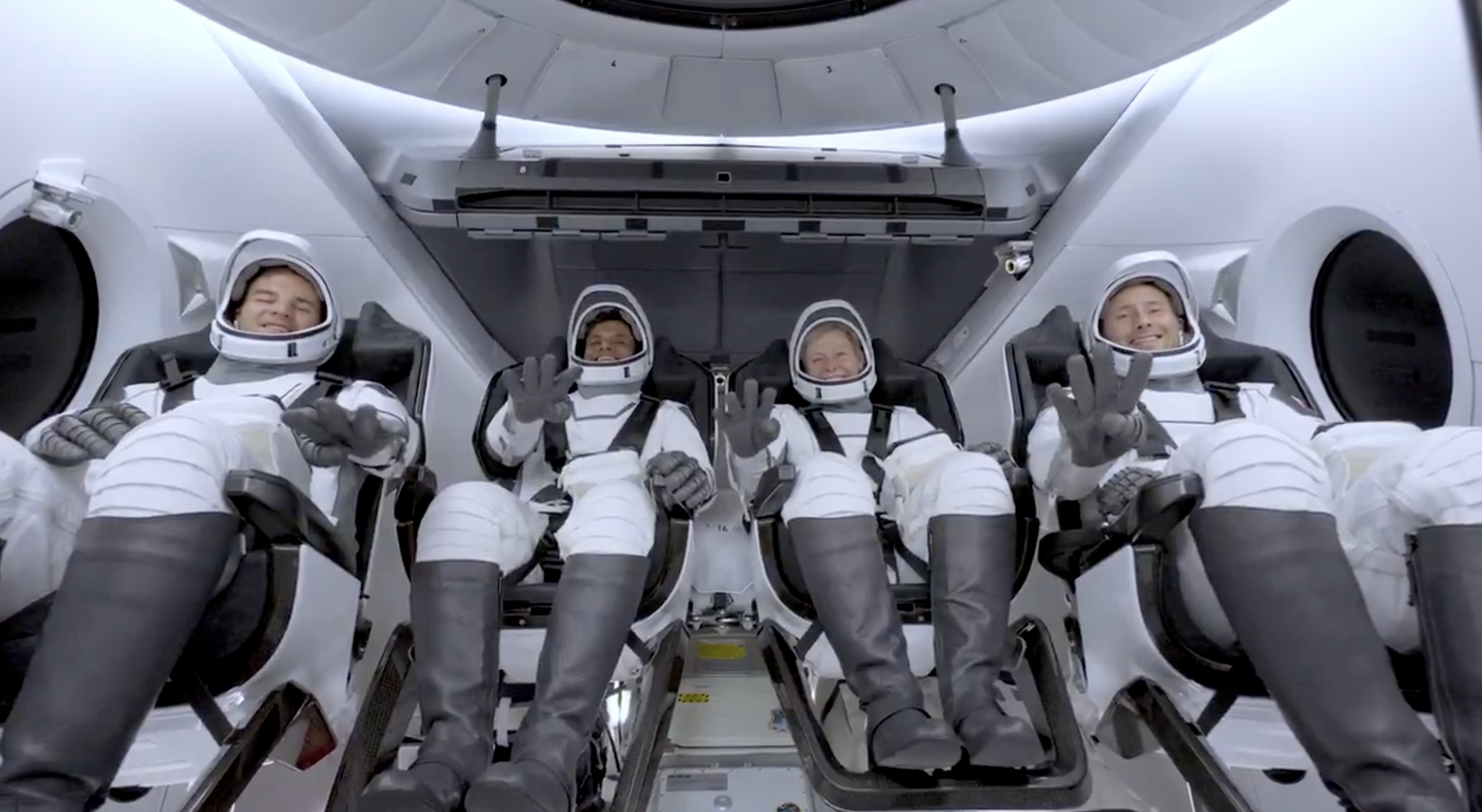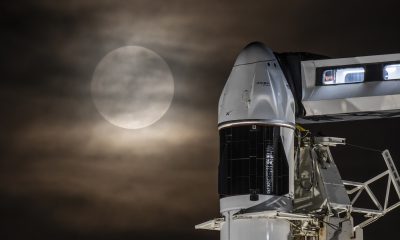

SpaceX
SpaceX hangar packed with Falcon Heavy Block 5 boosters for early April debut
For a company that rarely reveals anything without explicit intent, a February 28th video posted by SpaceX during the lead-up to Crew Dragon’s launch debut featured a surprise cameo: two Block 5 side boosters meant to support Falcon Heavy’s commercial debut and second launch ever.
Likely a subtle nod to close observers and fans, the inclusion of Falcon Heavy is a perfect bit of foreshadowing for the next launch set to occur from Pad 39A after Crew Dragon’s flawless orbital debut. As of now, Falcon Heavy Flight 2 is settling in on a potential launch as early as the first week of April, although delays during the rocket’s critical preflight processing and static fire test are about as likely as they were during the vehicle’s inaugural mission. If the rocket’s first launch and booster recoveries are fully successful, both side boosters (and perhaps the center core) could fly for a second time as few as two months later in June 2019.
A number of photos taken by Instagram users visiting Kennedy Space Center appear to indicate that SpaceX has more or less completed the reconfiguration of Pad 39A’s transporter/erector (T/E), modifying the base with additional hold-down clamps to account for three Falcon boosters instead of the usual one. Ten days after the successful launch of Falcon 9 B1051 in support of Crew Dragon’s first mission to orbit, it’s likely that additional work remains to ensure that 39A is fully refurbished and reconfigured for Falcon Heavy.
For the heavy-lift rocket’s commercial debut and second flight ever, SpaceX is likely to be exceptionally cautious and methodical in their preflight preparations. This is especially necessary due to the fact that Falcon Heavy Flight 2 differs dramatically from Falcon Heavy’s demo configuration, degrading the applicability of some aspects of the data gathered during the rocket’s largely successful test flight.
Most notably, all three first stage boosters will be Block 5 variants on their first flights, whereas Flight 1’s first stage featured two flight-proven Block 2 boosters (B1023 and B1025) and one new Block 3 booster (B1033). Additionally, the center core – B1033 – was lost during a landing anomaly that prevented the booster from reigniting its engine for a landing burn, cutting off another valuable source of data that would have served to better inform engineers on the performance of Falcon Heavy’s complex and previously unproven mechanical stage separation mechanisms.

Falcon 9 Block 5 is a fairly radical departure from the Block 2 and 3 variants SpaceX based Falcon Heavy’s initial design on. It’s possible that the rocket’s engineers were able to at least set up that design and manufacturing work on a safe path to forward compatibility, but it’s equally possible that so much work was focused on simply getting the vehicle past its launch debut that compatibility with Falcon 9 Block 4 and 5 was pushed well into the periphery. Considering the fact that it has now been more than a year since Falcon Heavy’s February 6th, 2018 debut, the latter eventuality offers a much better fit. Nevertheless, with a solid 13-14 additional months of redesign and testing complete, it seems that SpaceX is keen to get its super heavy-lift launch vehicle back on the horse, so to speak.
The specific changes made in Falcon 9 Block 4 is unclear aside from a general improvement in Merlin 1D and MVac performance, as well as significant upgrades to Falcon 9’s upper stage, likely focused on US military and NASA requirements for long-coast capabilities on unique mission profiles. Most significantly, Falcon 9 Block 5 transitioned the SpaceX rocket to a radically different primary thrust structure (also known as the octaweb), replacing welded assemblies with bolted assemblies wherever possible. This simultaneously allows for easier repairs and modifications, improves ease of manufacture, and increases the structure’s overall strength, a critical benefit for Falcon Heavy’s heavily-stressed center core. Meanwhile, Falcon 9 Block 5 moved from Full Thrust’s (Block 3/4) maximum 6800 kN (1,530,000 lbf) of thrust to more than 7600 kN (1,710,000 lbf), an increase of roughly 12%. Combined with Block 5’s focus on extreme reusability, SpaceX engineers and technicians likely had to do a huge amount of work to leap from Falcon Heavy Flight 1 to Flight 2.

Aside from the presence of both Falcon Heavy side boosters, both of which were spotted arriving in Florida by local observers, the first Block 5 Falcon Heavy center core also very likely arrived within the last few months, followed rapidly by can be assumed to be the mission’s fairing and Falcon upper stage. Falcon Heavy’s commercial debut will see the rocket attempt to place communications satellite Arabsat 6A – weighing around 6000 kg (13,200 lb) – into a high-energy geostationary orbit, either direct-to-GEO or a transfer (GTO) variety.
If all goes according to plan, SpaceX will attempt to turn around Falcon Heavy’s Block 5 side boosters (B1052 and B1053) for Falcon Heavy’s third launch – the USAF’s STP-2 mission – as few as 60-80 days later, June 2019. According to NASASpaceflight, STP-2 will fly with a new center core (presumed to be B1057) instead of reusing Arabsat 6A’s well-cooked B1055 booster.
Check out Teslarati’s Marketplace! We offer Tesla accessories, including for the Tesla Cybertruck and Tesla Model 3.
News
SpaceX launches Ax-4 mission to the ISS with international crew
The SpaceX Falcon 9 launched Axiom’s Ax-4 mission to ISS. Ax-4 crew will conduct 60+ science experiments during a 14-day stay on the ISS.

SpaceX launched the Falcon 9 rocket kickstarting Axiom Space’s Ax-4 mission to the International Space Station (ISS). Axiom’s Ax-4 mission is led by a historic international crew and lifted off from Kennedy Space Center’s Launch Complex 39A at 2:31 a.m. ET on June 25, 2025.
The Ax-4 crew is set to dock with the ISS around 7 a.m. ET on Thursday, June 26, 2025. Axiom Space, a Houston-based commercial space company, coordinated the mission with SpaceX for transportation and NASA for ISS access, with support from the European Space Agency and the astronauts’ governments.
The Ax-4 mission marks a milestone in global space collaboration. The Ax-4 crew, commanded by U.S. astronaut Peggy Whitson, includes Shubhanshu Shukla from India as the pilot, alongside mission specialists Sławosz Uznański-Wiśniewski from Poland and Tibor Kapu from Hungary.
“The trip marks the return to human spaceflight for those countries — their first government-sponsored flights in more than 40 years,” Axiom noted.
Shukla’s participation aligns with India’s Gaganyaan program planned for 2027. He is the first Indian astronaut to visit the ISS since Rakesh Sharma in 1984.
Axiom’s Ax-4 mission marks SpaceX’s 18th human spaceflight. The mission employs a Crew Dragon capsule atop a Falcon 9 rocket, designed with a launch escape system and “two-fault tolerant” for enhanced safety. The Axiom mission faced a few delays due to weather, a Falcon 9 leak, and an ISS Zvezda module leak investigation by NASA and Roscosmos before the recent successful launch.
As the crew prepares to execute its scientific objectives, SpaceX’s Ax-4 mission paves the way for a new era of inclusive space research, inspiring future generations and solidifying collaborative ties in the cosmos. During the Ax-4 crew’s 14-day stay in the ISS, the astronauts will conduct nearly 60 experiments.
“We’ll be conducting research that spans biology, material, and physical sciences as well as technology demonstrations,” said Whitson. “We’ll also be engaging with students around the world, sharing our experience and inspiring the next generation of explorers.”
SpaceX’s Ax-4 mission highlights Axiom’s role in advancing commercial spaceflight and fostering international partnerships. The mission strengthens global space exploration efforts by enabling historic spaceflight returns for India, Poland, and Hungary.
News
Starlink Cellular’s T-Mobile service to grow with third-party app data
From Oct 2025, T-Satellite will enable third-party apps in dead zones! WhatsApp, X, AccuWeather + more coming soon.

Starlink Cellular’s T-Mobile service will expand with third-party app data support starting in October, enhancing connectivity in cellular dead zones.
T-Mobile’s T-Satellite, supported by Starlink, launches officially on July 23. Following its launch, T-Mobile’s Starlink Cellular service will enable data access for third-party apps like WhatsApp, X, Google, Apple, AccuWeather, and AllTrails on October 1, 2025.
T-Mobile’s Starlink Cellular is currently in free beta. T-Satellite will add MMS support for Android phones on July 23, with iPhone support to follow. MMS support allows users to send images and audio clips alongside texts. By October, T-Mobile will extend emergency texting to all mobile users with compatible phones, beyond just T-Mobile customers, building on its existing 911 texting capability. The carrier also provides developer tools to help app makers integrate their software with T-Satellite’s data service, with plans to grow the supported app list.
T-Mobile announced these updates during an event celebrating an Ookla award naming it the best U.S. phone network, a remarkable turnaround from its last-place ranking a decade ago.
“We not only dream about going from worst to best, we actually do it. We’re a good two years ahead of Verizon and AT&T, and I believe that lead is going to grow,” said T-Mobile’s Chief Operating Officer Srini Gopalan.
T-Mobile unveiled two promotions for its Starlink Cellular services to attract new subscribers. A free DoorDash DashPass membership, valued at $10/month, will be included with popular plans like Experience Beyond and Experience More, offering reduced delivery and service fees. Meanwhile, the Easy Upgrade promotion targets Verizon customers by paying off their phone balances and providing flagship devices like the iPhone 16, Galaxy S25, or Pixel 9.
T-Mobile’s collaboration with SpaceX’s Starlink Cellular leverages orbiting satellites to deliver connectivity where traditional networks fail, particularly in remote areas. Supporting third-party apps underscores T-Mobile’s commitment to enhancing user experiences through innovative partnerships. As T-Satellite’s capabilities grow, including broader app integration and emergency access, T-Mobile is poised to strengthen its lead in the U.S. wireless market.
By combining Starlink’s satellite technology with strategic promotions, T-Mobile is redefining mobile connectivity. The upcoming third-party app data support and official T-Satellite launch mark a significant step toward seamless communication, positioning T-Mobile as a trailblazer in next-generation wireless services.
News
Starlink expansion into Vietnam targets the healthcare sector
Starlink aims to deliver reliable internet to Vietnam’s remote clinics, enabling telehealth and data sharing.

SpaceX’s Starlink expansion into Vietnam targets its healthcare sector. Through Starlink, SpaceX seeks to drive digital transformation in Vietnam.
On June 18, a SpaceX delegation met with Vietnam’s Ministry of Health (MoH) in Hanoi. SpaceX’s delegation was led by Andrew Matlock, Director of Enterprise Sales, and the discussions focused on enhancing connectivity for hospitals and clinics in Vietnam’s remote areas.
Deputy Minister of Health (MoH) Tran Van Thuan emphasized collaboration between SpaceX and Vietnam. Tran stated: “SpaceX should cooperate with the MoH to ensure all hospitals and clinics in remote areas are connected to the StarLink satellite system and share information, plans, and the issues discussed by members of the MoH. The ministry is also ready to provide information and send staff to work with the corporation.”
The MoH assigned its Department of Science, Technology, and Training to work with SpaceX. Starlink Vietnam will also receive support from Vietnam’s Department of International Cooperation. Starlink Vietnam’s agenda includes improving internet connectivity for remote healthcare facilities, developing digital infrastructure for health examinations and remote consultations, and enhancing operational systems.
Vietnam’s health sector is prioritizing IT and digital transformation, focusing on electronic health records, data centers, and remote medical services. However, challenges persist in deploying IT solutions in remote regions, prompting Vietnam to seek partnerships like SpaceX’s.
SpaceX’s Starlink has a proven track record in healthcare. In Rwanda, its services supported 40 health centers, earning praise for improving operations. Similarly, Starlink enabled remote consultations at the UAE’s Emirati field hospital in Gaza, streamlining communication for complex medical cases. These successes highlight Starlink’s potential to transform Vietnam’s healthcare landscape.
On May 20, SpaceX met with Vietnam’s Ministry of Industry and Trade, announcing a $1.5 billion investment to provide broadband internet, particularly in remote, border, and island areas. The first phase includes building 10-15 ground stations across the country. This infrastructure will support Starlink’s healthcare initiatives by ensuring reliable connectivity.
Starlink’s expansion in Vietnam aligns with the country’s push for digital transformation, as outlined by the MoH. By leveraging its satellite internet expertise, SpaceX aims to bridge connectivity gaps, enabling advanced healthcare services in underserved regions. This collaboration could redefine Vietnam’s healthcare infrastructure, positioning Starlink as a key player in the nation’s digital future.
-

 Elon Musk4 days ago
Elon Musk4 days agoTesla investors will be shocked by Jim Cramer’s latest assessment
-

 News1 week ago
News1 week agoTesla Robotaxi’s biggest challenge seems to be this one thing
-

 Elon Musk2 weeks ago
Elon Musk2 weeks agoFirst Look at Tesla’s Robotaxi App: features, design, and more
-

 News2 weeks ago
News2 weeks agoSpaceX and Elon Musk share insights on Starship Ship 36’s RUD
-

 News2 weeks ago
News2 weeks agoWatch Tesla’s first driverless public Robotaxi rides in Texas
-

 News1 week ago
News1 week agoWatch the first true Tesla Robotaxi intervention by safety monitor
-

 News2 weeks ago
News2 weeks agoTesla has started rolling out initial round of Robotaxi invites
-

 Elon Musk2 weeks ago
Elon Musk2 weeks agoTesla to launch in India in July with vehicles already arriving: report


















